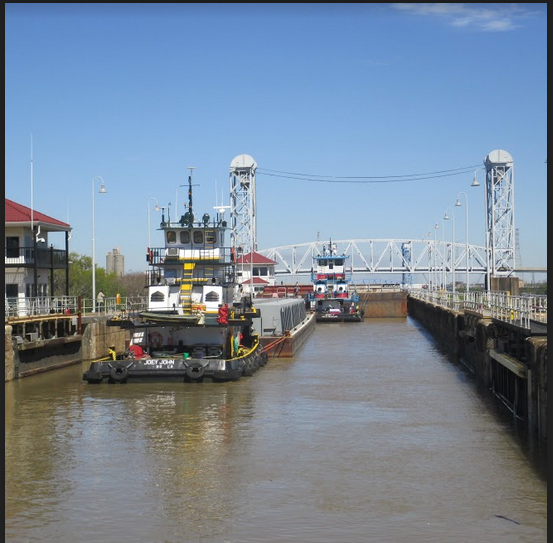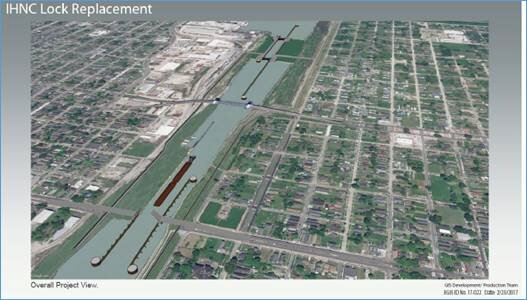Entire City Shares Risks of Corps’ Industrial Canal Lock Relocation and Expansion
By Sandra L. Stokes
Chairman, Louisiana Landmarks Society Advocacy Committee
As the U.S. Army Corps of Engineers’ Inner Harbor Navigational Canal (IHNC) Lock Replacement project rears its head again, Louisiana Landmarks Society continues to advocate for the safety of the city, opposing the project as currently planned. The risks and problems it will bring to New Orleans far outweigh any benefits. Before embarking on an outdated scheme with significant consequences, we believe the Corps of Engineers should evaluate the project using current information – particularly the dramatic changes that have occurred since the 22 year old decision to build the lock was made.
The IHNC lock has been instrumental for maritime shipping as it connects the Mississippi River to Lake Pontchartrain and the Gulf Intracoastal Waterway. The proposed new location with a wider lock could facilitate faster passage for shipping and comes with an optimistic price tag of $951,000,000. Of profound concern, the new lock would be built twelve blocks deeper into the city – bringing with it the Mississippi River and its higher level of water. Dredging for the new lock along with the removal of the current lock, 225,000 tons of hardened concrete and comparable in size to the Chrysler Building, create tremendous risks that range from catastrophic levee failure to environmental safety concerns when known toxic soils are dredged up and shipped to a landfill.
The timeline for construction is projected at minimally 13 years – promising to snarl traffic to and from St. Bernard Parish and the Lower Ninth Ward not only due to the complicated replacement of the National Register eligible lock and St. Claude bascule Bridge, but long after construction ends. Because the Mississippi River would infiltrate to approximately Galvez Street, it is estimated that with a 7-15 feet higher river level at Claiborne Avenue, the drawbridge will need to be raised more often, estimated from the present rate of 15% of boat traffic to up to 70% – and be “up” approximately 40% longer for navigation of the longer tows.
Many factors that should affect the decision for the lock have drastically changed, including the closure of the Mississippi River Gulf Outlet (MRGO), the shift from accommodating deep water draft ships to now only shallow draft, the withdrawal of the Port of New Orleans as the local sponsor, new pipeline construction, and changes in barge traffic including the commodities shipped (i.e. in 1989, coal and petroleum products comprised 71.7% of the traffic through the lock but are not the vibrant commodities they once were). Yet the Corps has performed no studies that include this new information to determine basic premises, such as the current validity of the decades-old decision to site the project at this location, or if faster passage and/or if the savings for the shipping industry is truly worth the costs, risks, and myriad of problems that will undoubtedly ensue. Any supposed benefits accrue to the companies using the shipping lanes and certainly not New Orleans businesses or residents.
A few excerpts from Louisiana Landmarks Society’s letter submitted to the Corps of Engineers for the federal Section 106 process state: “We seem to be moving forward with a plan that was written twenty-two years ago but never enacted, adding the assumption that all deciding factors have remained frozen in time since then. In any rational world this would, of course, be totally unacceptable – but in New Orleans it even has more significance. Enormous changes have occurred: the urban landscape has expanded, the MRGO has been closed, significant structural changes have been made, the channel is no longer to be deep-draft, the Port Authority of New Orleans is no longer participating, etc. But most of all, Hurricane Katrina – with her vast array of challenges – has hopefully changed every way of thinking.”
“Of deep concern is the lack of consideration for the next hurricane that requires evacuation of the city and waterways. The much needed reevaluation of alternatives provides the opportunity for serious review of all possibilities and assessment of the optimal site for the lock – not just for maritime commerce, but the City of New Orleans and its residents. The current location of the lock jeopardizes safety of citizens as difficult choices are required to either open bridges for maritime vessels maneuvering to safety, or allow thousands of vehicles to evacuate the hurricane’s path. This is an immense problem with catastrophic consequences – yet the proposed project does not seem to include it in the consideration. …The number of people who died due to difficulties evacuating during Hurricane Katrina is just one reason this must be part of the equation before heading down the 22 year old pre-Katrina path.”
“An up-to-date economic analysis that looks at the cost/benefit of each of the alternatives using current information must be conducted. It should include the economic costs to all areas of the city and its immediate surrounding area (including St. Bernard Parish), resources, neighborhoods, businesses and residents (both homeowners and renters), time, traffic (including public transportation), added risks, etc. – compared with the monetized gains realized by vessels clearing the lock in less time – taking into account the new shallow draft restriction.”
“It is imperative that the Corps conduct a comprehensive traffic study, a new Environmental Impact Study (EIS) and a study of the impacts to the urban area incorporating current data.”
“… this is 22 year old material that assumes a static world and needs. A new, open and transparent process of “broad-based community participation” needs to be conducted, with new participants who represent the current population, to include consideration of the changing environment and needs.”
“… we can’t ignore that the move to pick up a 22 year old MOA (Memorandum of Understanding) and plod forward is simply not a reasonable approach. The USACE must take a step back and study all alternatives using current data and information. It would be negligent to do anything less.”
You can help: Sign the petition at www.stopthelock.com. To learn more, watch the twelve-minute video “Locked” at www.stopthelock.com. Contact your Congressmen at the following addresses:
U.S. Representative Cedric Richmond
https://richmond.house.gov
(202) 225-6636 – D.C. Office
U.S. Senator Bill Cassidy
https://www.cassidy.senate.gov/contact
(202) 224-5824 – D.C. Office
U.S. Senator John Kennedy
(202) 224-4623 – D.C. Office
https://www.kennedy.senate.gov/public/

